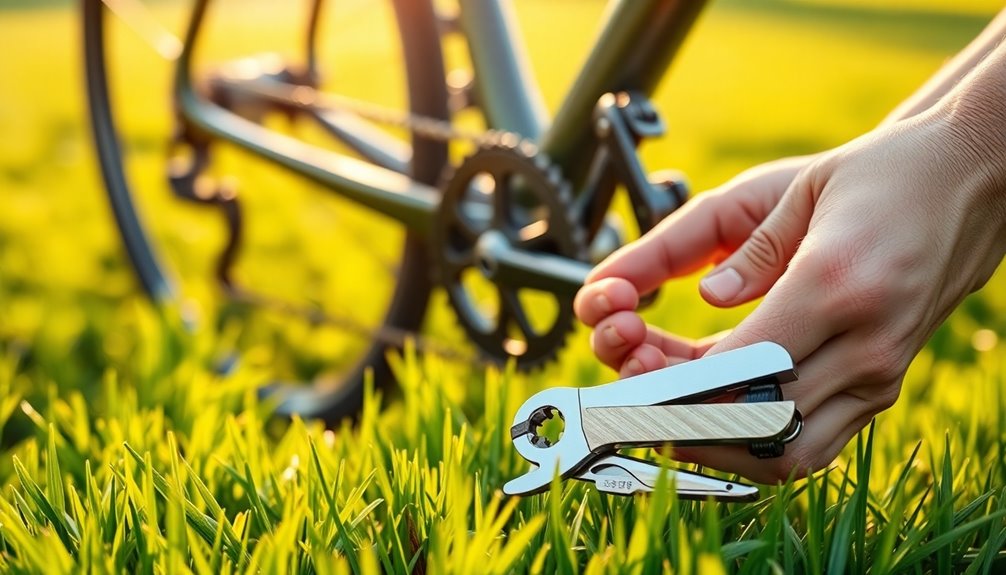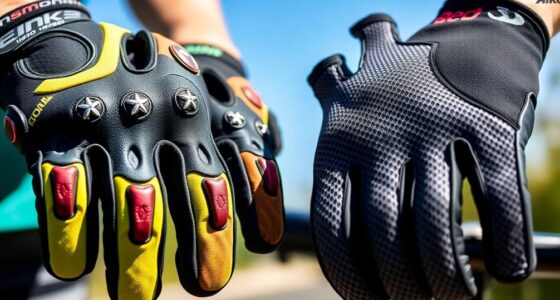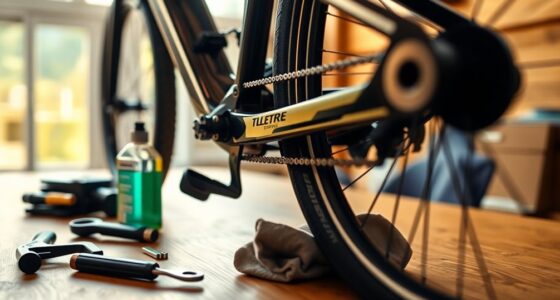To get started with basic bike maintenance, you'll need essential tools like a multi-tool, tire pump, and tire levers. Perform a pre-ride safety check by inspecting tires, brakes, and the chain. Keep your tires properly inflated and learn how to fix punctures with a repair kit. Regularly clean your bike and lubricate the chain. Don't forget to adjust your brakes and gears for smooth operation. Stick around, and you'll pick up even more handy tips and tricks!
Key Takeaways
- Always perform a pre-ride safety check, including tire inspection, brake functionality, and tightening critical bolts.
- Keep essential tools on hand, such as a multi-tool, tire pump, tire levers, and chain lube for basic repairs.
- Regularly clean your bike, especially the chain, to prevent dirt buildup and prolong component life.
- Check and maintain tire pressure regularly, ensuring performance tires are between 80-130 psi and mountain tires between 30-50 psi.
- Adjust brakes and gears as needed, monitoring cable tension and replacing worn brake pads for optimal performance.
Essential Tools for Bike Maintenance

When you plunge into bike maintenance, having the right tools at your fingertips makes all the difference. A reliable multi-tool is vital; it typically includes various sizes of Allen wrenches and screwdrivers for quick adjustments.
Having the right tools, like a multi-tool, is essential for effective bike maintenance and quick adjustments.
Don't forget a tire pump with a pressure gauge to keep your tires inflated for peak performance. Tire levers are essential for removing tires during flat repairs, while a spare inner tube and patch kit guarantee you're prepared for emergencies.
Regularly applying chain lube reduces friction, extends component life, and guarantees smooth gear shifts.
Finally, keep an eye on your brake pads and know how to perform derailleur adjustments—these tools and skills are the backbone of basic bike maintenance, making your rides safer and more enjoyable.
Conducting a Pre-Ride Safety Check
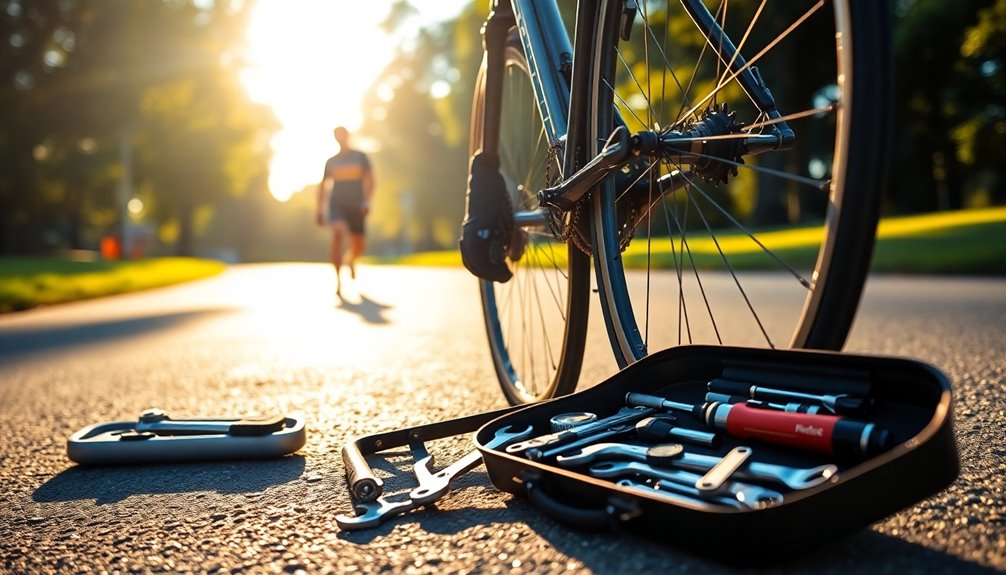
Before you hit the road, a quick pre-ride safety check can confirm your bike is ready for action. Start with the M-check: inspect tires for cuts or wear, check tire pressure, and verify quick releases are snug. Test brake functionality by pulling the levers and rolling the bike; adequate pad life is essential. Don't forget to inspect the chain for wear and verify proper lubrication for smooth shifts. Finally, tighten bolts, especially on the stem and handlebars, to avoid mechanical issues.
| Task | What to Check | Importance |
|---|---|---|
| Tire Pressure | Verify proper inflation | Prevents flats and affects handling |
| Brake Functionality | Engage brake levers | Ensures safety and control |
| Chain Lubrication | Apply lubricant | Reduces wear and enhances performance |
| Tighten Bolts | Check critical bolts | Maintains bike integrity |
Tire Care: Inflation and Puncture Repair
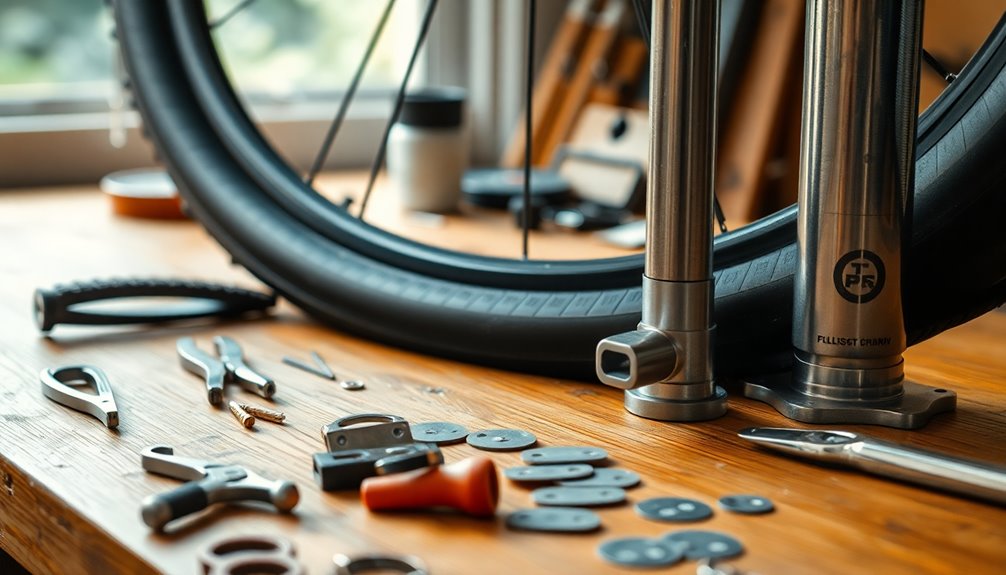
Maintaining proper tire care is essential for a smooth and safe ride. Regularly check your tire pressure before every ride, as performance bike tires should be between 80-130 psi, while mountain bike tires typically range from 30-50 psi.
To avoid a flat tire, carry a repair kit with a spare inner tube, tire levers, and an inflation device like a CO2 cartridge or pump. If you encounter a puncture, remove the wheel, use tire levers to take off the tire, and replace the tube, ensuring the tire is seated properly before reinserting the wheel.
Inspect your tires for cuts and embedded debris as a preventative measure to help avoid punctures and enhance your riding experience.
Keeping Your Bike Clean
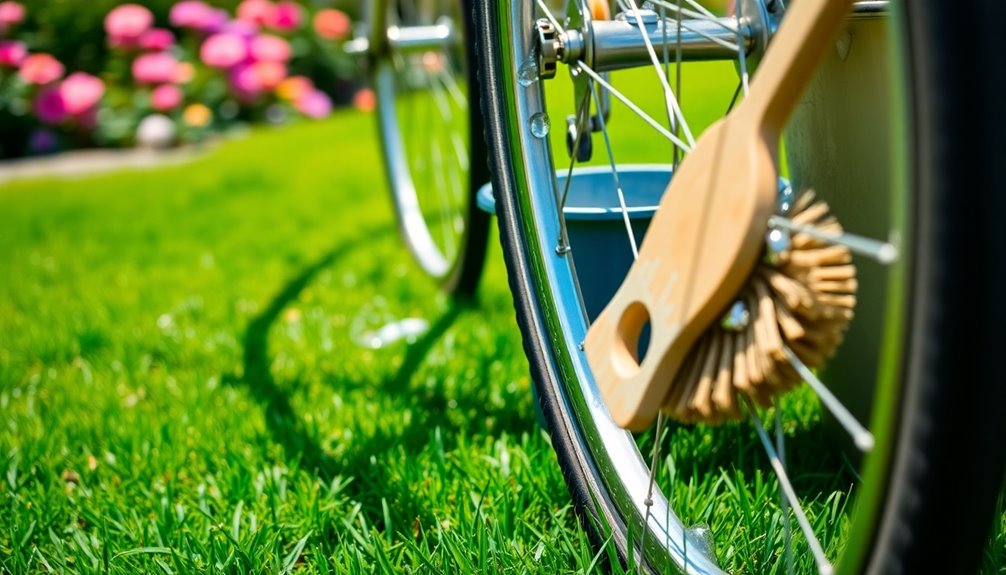
Cleaning your bike regularly—ideally every couple of weeks—keeps it in top shape and enhances its performance.
Start by focusing on your chain; a clean chain helps prevent dirt and grime from damaging the drivetrain, which can prolong its lifespan. Use a bucket, sponge, and mild dish soap for general cleaning. Avoid pressure washers that can force water into bearings.
After cleaning, make sure to thoroughly dry your bike to prevent rust, especially on metal components. You should also aim to clean your bike more frequently after muddy rides.
Chain Care and Lubrication

Your bike's chain is essential for smooth rides, and proper care is key to its longevity.
Regular maintenance involves cleaning the chain with a rag while back pedaling to remove dirt and grime. For a thorough clean, use a chain cleaning tool at least once a month.
When lubing your chain, do it while back pedaling to guarantee the lubricant penetrates the links. Wipe off any excess to prevent dirt accumulation. A well-lubed chain should have a slight sheen, indicating peak performance.
Aim to lubricate your chain at least once a week, or every 3-5 days if you ride often, to prolong the life of your drivetrain.
Don't forget to inspect the chain regularly for signs of wear and replace it if needed.
Brake and Gear Adjustments

Maintaining your bike's brakes and gears is essential for a safe ride.
You'll want to check the brake pads regularly and replace them when they're worn down, ensuring you can stop effectively.
Adjusting the cable tension is also vital; a simple turn of the barrel adjuster can make a big difference in how responsive your brakes feel.
Cable Tension Adjustment
When you adjust cable tension, you guarantee that your bike's brakes respond effectively and that gear shifts happen smoothly. Proper cable tension is essential for both brake adjustments and derailleur performance.
Too much tension can cause brakes to drag, while too little can lead to ineffective stopping or missed shifts. To increase brake cable tension, simply turn the barrel adjuster counter-clockwise to bring the pads closer to the rim.
For derailleur adjustments, unthreading the barrel adjuster increases tension for larger cogs; decreasing tension helps with smaller cogs.
Regularly check and adjust cable tension to maintain peak performance and safety. Make it a habit to inspect your bike at least once a month or after significant rides to confirm everything's functioning correctly.
Brake Pad Replacement
After ensuring your cable tension is properly adjusted, the next step in bike maintenance is replacing worn brake pads.
Regularly inspect your brake pads for wear; replace them when the material is down to 1-2 mm for peak brake performance and safety.
For rim brakes, align the pads with the rim surface and adjust the angle to prevent noise and uneven wear. If you have disc brakes, check the thickness and replace them if they fall below the manufacturer's minimum, usually around 1.5 mm.
Use the barrel adjuster to fine-tune your brake cable tension, ensuring the brake pads engage effectively.
Finally, test the braking system by squeezing the levers to confirm proper engagement before heading out for a ride. This routine maintenance can enhance your bike's performance and promote emotional resilience as you enjoy your rides.
Learning Through Bike Maintenance Classes
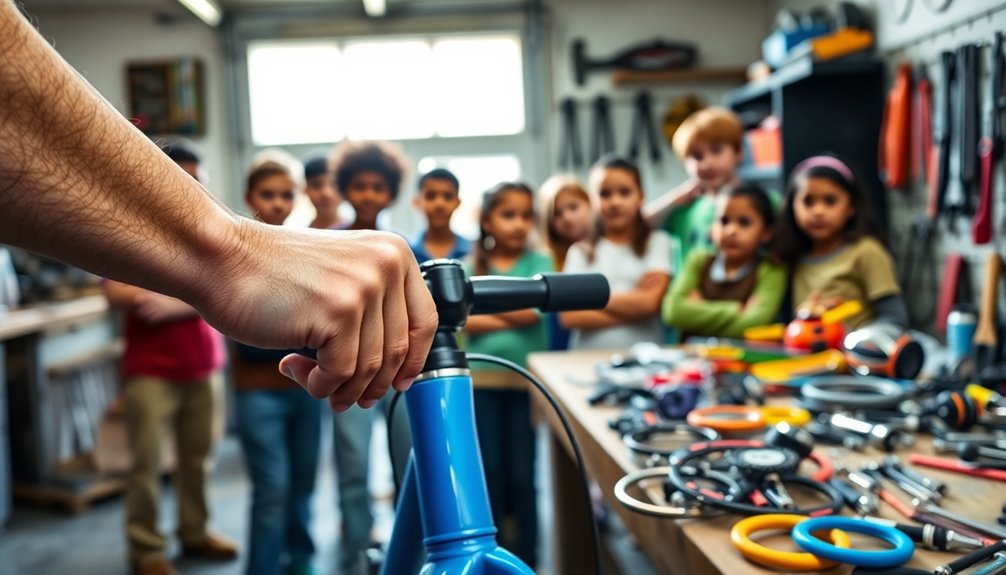
Participating in bike maintenance classes not only equips you with essential skills but also boosts your confidence as a cyclist.
These hands-on sessions, often hosted by local bike shops or community centers, provide valuable experience in fixing flat tires, adjusting brakes, and lubricating chains. Led by experienced mechanics, you'll learn both the theory and practical aspects of bike care.
Gain hands-on experience in bike maintenance, from fixing flat tires to adjusting brakes, guided by skilled mechanics.
Instructional materials and demonstrations enhance your understanding, making it easier to tackle common bike issues independently. Furthermore, engaging in these classes fosters a sense of community among cyclists, allowing you to share experiences and challenges with others.
Ultimately, you'll gain self-sufficiency and the skills needed to keep your bike in top shape, ensuring many enjoyable rides ahead.
Frequently Asked Questions
How Do You Maintain a Bike for Beginners?
To maintain your bike, start by checking tire pressure before each ride, aiming for the recommended psi.
Clean it every couple of weeks, especially after muddy rides, using dish soap and a sponge.
Lubricate your chain weekly, or more often if you ride frequently.
Perform a quick safety check on tires, brakes, and components.
Finally, carry basic repair tools, like a multi-tool and spare tube, so you can handle minor issues on your own.
What Regular Maintenance Should Be Done on a Bike?
You wouldn't want to hit the road with a flat tire, right? To keep your bike in top shape, conduct daily checks on tire pressure, brakes, and bolts.
Weekly, lubricate your chain and check brake pads.
Monthly, inspect chain wear and adjust derailleurs.
Don't forget to monitor saddle height to avoid slipping.
Finally, schedule a professional service at least once a year to tackle any major issues and guarantee your bike's longevity.
What's Needed for Bike Maintenance?
For bike maintenance, you'll need a few essential tools. A multi-tool, tire levers, and a quality bike pump are must-haves for basic repairs.
Don't forget a spare inner tube for flat tires. Keeping your bike clean is crucial, so have brushes, rags, and degreaser on hand.
Regularly check your brake cables and pads, so include Allen wrenches and an adjustable crescent wrench in your toolkit for safety and effectiveness.
How Do I Service My Bike Myself?
To service your bike yourself, start by debunking the myth that it's too complicated. You can easily perform basic maintenance tasks.
Begin with an M-check, inspecting tires, wheels, and the drivetrain. Regularly clean and lubricate your chain.
Check tire pressure before every ride, ensuring it matches the recommended psi. Familiarize yourself with adjusting brakes and derailleurs for smooth operation.
Finally, create a maintenance schedule to keep your bike in peak condition.
Conclusion
Just like a well-tuned engine powers a smooth ride, keeping your bike in top shape guarantees you enjoy every journey. Regular maintenance not only enhances performance but also extends your bike's lifespan. By following these essential tips, you're not just a rider; you're a caretaker of your two-wheeled companion. So, grab your tools, embrace the process, and let every ride be a tribute to your diligence and passion for cycling. Happy riding!
